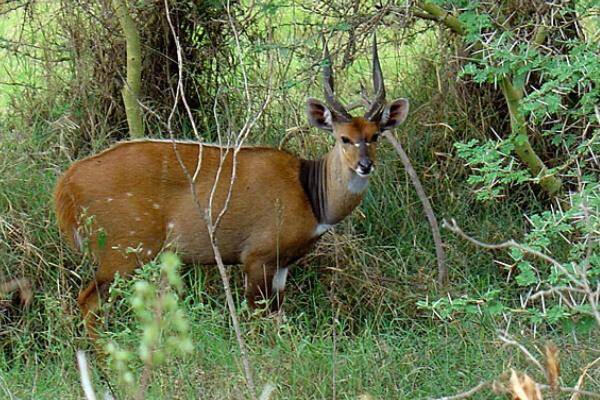Tragelaphus scriptus
IUCN
LCBasic Information
Scientific classification
- name:Tragelaphus scriptus
- Scientific Name:Tragelaphus scriptus,bush antelope
- Outline:Ungulata
- Family:Artiodactyla Bovidae Serow
Vital signs
- length:100-125cm
- Weight:25-80kg
- lifetime:About 15 years
Feature
Mainly brownish red or yellowish brown, with distinct vertical stripes, males have long spiral horns
Distribution and Habitat
Origin: Angola, Benin, Botswana, Burkina Faso, Burundi, Cameroon, Central African Republic, Chad, Congo, Democratic Republic of Congo, Côte d'Ivoire, Equatorial Guinea, Ethiopia, Gabon, Gambia, Ghana, Guinea, Guinea-Bissau, Kenya, Liberia, Malawi, Mali, Mauritania, Mozambique, Namibia, Niger, Nigeria, Rwanda, Senegal, Sierra Leone, Somalia, South Africa, South Sudan, Sudan, Swaziland, United Republic of Tanzania, Togo, Uganda, Zambia and Zimbabwe.
Possibly extinct: Lesotho.
The bushbuck lives in most of Africa south of the Sahara Desert, in open savannas and montane forests, jungles and dense wooded areas. The species is widespread and survives almost regardless of altitude or aridity as long as there is adequate vegetation cover. Lives on the edge of forests or in flower-filled meadows adjacent to rivers and streams.
Appearance
Male bushbucks are larger than females, weighing 40-80 kg and 70-100 cm at the shoulder; females weigh about 25-60 kg and are 65-85 cm at the shoulder. Only males have horns, which are 25-55 cm long, almost straight, usually spiraling only once, and parallel to each other. The fur ranges from dark brown, chestnut to light brown in color. Females are usually lighter in color than males. Both sexes have white spots and stripes. There are up to 7 different patterns of white stripes and spots on the face, depending on the geographically distributed subspecies. There are 1-2 white spots on the cheeks, white stripes at the corners of the eyes, and a white muzzle. The underside of the bushy tail is white.
Details
Bushbuck (scientific name: Tragelaphus scriptus) is also known as Bushbuck in foreign languages. There are 10 subspecies.

Bushbuck is the least social of the African antelopes. Often seen alone, although sometimes small groups of females and their young are found. Bushbucks are not territorial species and are not aggressive towards each other except for competing for mating rights with females during the rutting season, so they may gather in small groups of 25 or so to feed together in habitats with abundant pasture. Therefore, the traditional definition of them as "solitary" is a bit misleading.
Bushbucks are early morning and nocturnal foragers. These antelopes are primarily nocturnal, although they may also be active at dusk or dawn. They hide during the day to avoid dense predators (which includes almost all carnivores), and return to the group's living bush at night to feed in more open areas. They are usually active near rivers in areas with thick brush and tall grass and tree cover. They come out at night to forage in more open areas, but will never venture far from a certain type of area. Bushbucks have strong jumping ability and can easily jump over a 2-meter high fence. They are also very good swimmers.
Bushbucks are herbivorous species. They eat grasses and a wide variety of plant leaves, branches and flowers. When hungry they will eat a wide variety of plant species but are somewhat selective when possible, preferring soft creepers and sausage trees. Occasionally they will eat fresh grass.

Bushbucks can mate and reproduce all year round, and young can be born at any time of the year, but in arid areas, birth rates peak during the rainy season. The gestation period is only 180 days, and females can produce more than one young per year. Young antelopes weigh about 4 kg at birth. They do not follow their mothers into foraging pastures before they are 4 months old. At this time, it remains hidden in the dense bush, with its mother returning periodically to nurse it. Sexual maturity is reached after one year, but the male's horns do not reach adult length until three years of age.
The survival of bushbucks involves many problems. Perhaps most seriously, their numbers are controlled in areas near human cattle ranches. Because bushbucks live in woods and scrub close to rivers, they are often bitten by tsetse flies, which can cause nagana (sleeping sickness) and infect cattle. In pine forest areas, they cause damage by gnawing on the tops of young trees, causing juniper trees to over-branch. In addition, bushbucks often visit human communities on the outskirts of towns, where they damage people's gardens.
There are no special protection measures for bushbucks. They can coexist with humans more easily than many other species, and in some areas they are considered pests and their numbers are controlled. The species has a wide distribution range and is not close to the vulnerable and endangered threshold standard for species survival (distribution area or fluctuation range less than 20,000 square kilometers, habitat quality, population size, and fragmented distribution area). The population trend is stable, so it is evaluated as a species with no survival crisis.
Listed in the 2016 Red List of Endangered Species of the World Conservation Union (IUCN) ver3.1-Least Concern (LC).
Protect wild animals and eliminate game.
Maintaining ecological balance is everyone's responsibility!








